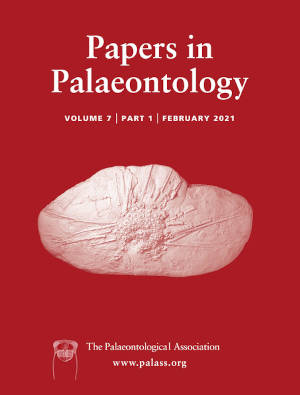Reg. Charity No. 1168330

High-resolution analysis of the late Pliensbachian – early Toarcian belemnite assemblages from the Peniche section (Lusitanian Basin) has enabled, for the first time, recognition of eight taxa of the suborder Belemnitina, previously reported from contemporaneous north-west Tethyan and Arctic sections. The presence of Bairstowius amaliae sp. nov. in the late Pliensbachian (emaciatum Zone) represents a novelty given that hitherto the genus Bairstowius was known only from late Sinemurian and early Pliensbachian deposits. Additionally, the replacement of Bairstowius amaliae by Catateuthis longiforma, during the latest Pliensbachian, suggests an evolutionary relationship between the two taxa. This relationship suggests a new scenario for the subsequent development of endemic Toarcian Boreal–Arctic faunas, characterized by the occurrence of Catateuthis. Comparison of the Peniche belemnite fauna with coeval faunas from the Mediterranean/Submediterranean and Euro-Boreal domains indicates taxonomic uniformity during the late Pliensbachian and early Toarcian (emaciatum and polymorphum Zones), in the north-west Tethys. Despite the lack of a marked taxonomic turnover, the Pliensbachian–Toarcian boundary corresponds to a slight decrease in diversity observed not only in the Lusitanian Basin but also in coeval north-western European basins. Ordination and cluster analyses indicate that the largest changes in belemnite diversity and palaeogeographical distribution occurred rather during the Toarcian Oceanic Anoxic Event (base of the levisoni Zone). This event is marked by the extinction of taxa, affecting more severely the Mediterranean/Submediterranean domain and resulting in a more pronounced provincial differentiation among north-western European and Arctic belemnite faunas.
AcknowledgementsWe thank Birgit Leipner-Mata for helping in belemnite preparation, and Paulina Nätscher, Christian Schulbert and Martina Schlott for assistance with scanning the specimens. We thank Wolfgang Kiessling for the valuable comments on the methods and Tarquin Bolton (Durham, UK) for information on British Pliensbachian belemnites. We thank Laura Piñuela, Johann Schobert, José Carlos García-Ramos and Pascal Neige for helping with fieldwork in Asturias and Normandy. We thank Peter Doyle and an anonymous reviewer for valuable comments on the manuscript. This is a contribution to the DFG Research Unit FOR 2332 (grant numbers Ba 5148/1-1, Ba 5148/1-2 to KDB) TERSANE and to the IGCP 655 (IUGS–UNESCO).